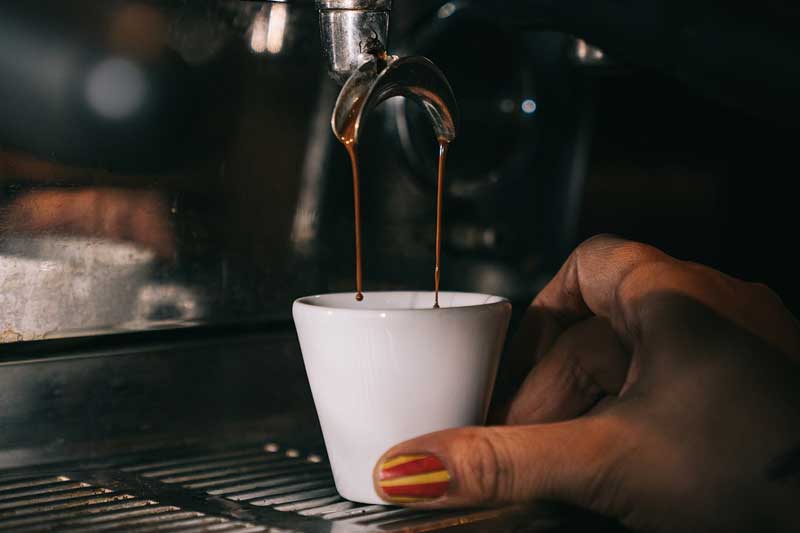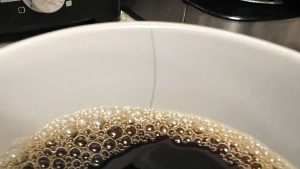This page may contain affiliate links. If you click and buy, we might get a small commission at no cost to you.
Coffee lovers are generally in agreement that stronger coffee=better coffee. Everyone also has their preferred brewing method, though, and so the question arises (and is hotly debated): which brewing method yields the strongest cup? In this article we’re
Which Brewing Method Makes the Strongest Coffee?
Espresso yields the coffee with the most flavor and caffeine per volume. Ounce for ounce, it’s the strongest coffee you can get. That said, “strong” can mean a lot of different things when we’re talking about coffee, so there’s still a lot to discuss here.
What exactly is strong coffee?
Strength is usually understood to mean caffeine content, but most people associated strength flavor with strength in caffeine, and many assume that dark roast coffee is as strong as it can get, so there are some things we need to clear up. Caffeine content and flavor or roast level are not necessarily linked.
Different Brewing Methods
Espresso
We’ve already stated that espresso is, ounce for ounce, the strongest coffee you can make. While this is true, it’s also a bit misleading because, in practical terms, espresso isn’t any stronger than regular old drip coffee.
Here’s what we mean: 2 ounces of espresso has more caffeine than 2 ounces of drip, and it has a very strong flavor, too. But when was the last time you poured a 2 ounce cup of drip coffee, or a 12 oz cup of pure espresso?
Espresso is highly concentrated coffee made by forcing hot water under high pressure through a puck of very finely ground coffee. Home espresso makers range from shockingly cheap to shockingly expensive, but there are some more affordably priced (yet still expensive options). It’s worth noting the truly cheap espresso makers are not worth the money- they break easily and don’t produce good coffee.
Drip
Automatic drip makers are the most common method of brewing coffee, especially at home. They’re affordable, easy to use, and can make a lot of coffee at once. Unfortunately, that coffee tends to be on the weak side. Drip makers don’t always heat the water to a suitable temperature, yielding coffee that’s lighter on flavor and caffeine than other methods. That said, if drip is what you like, there’s no reason not to make coffee this way.
Pour Over
Pour over is, basically, manual drip. You need a hot water kettle, a filter cone, a filter, and that’s about it. Depending on the equipment you buy this can range from very affordable to moderately expensive. This brewing method is the darling of the specialty coffee world.
Pour over produces a rich, clean cup with strong, clear flavors. The higher water temperature, more even saturation of the grounds, and higher ratio of coffee grounds to water when compared with automatic drip machines is responsible for this.
Chemex
Chemex is technically a pour over method, but the unique brewing vessel (which allows you to brew large amounts at once instead of single-cup pour over) and specialized filters set it apart. Chemex coffee has the clean, grit-free flavors and textures of pour over, but with much more body. The extra thick filters slow down the water as it travels through the grounds, leading to a fuller body and removing any chance of bitterness.
The Chemex brewing method yields a body similar to french press coffee- rich and heavy- with the bright clean flavors of a pour over. It’s an excellent way to brew a strong pot of coffee.
French Press
French press coffee has a strong, rich taste because there is no paper filter involved. The water is added to the grounds where it’s allowed to steep, and then a metal filter attached to a plunger is used to separate the grounds from the water. This method allows all of the natural oils of the coffee to remain in the water, along with the finer ground bits of the coffee itself.
French press coffee doesn’t necessarily contain more caffeine than coffee made with other brewing methods, but the flavor will be stronger and richer than any other (except, perhaps, Chemex or espresso.)
Moka Pot
Sometimes called stove top espresso, a moka pot actually doesn’t create enough pressure to make true espresso. Still, it’s very similar. Water is added to the bottom chamber, and the filter with coffee is inserted between the top and bottom chambers. As the water boils, pressure builds and forces the water through a tube up through the coffee grounds and into the top chamber.
The result is a concentrated, thick, strong brew. It’s somewhere between french press and espresso in taste and body.
Other Factors Contributing to Strength
Roast
Its commonly assumed that dark roast coffee is stronger than light roast, but actually the reverse is true. Caffeine breaks down under high heat, so the longer the coffee is in the roaster the less caffeine it has. Dark roasts have a more bitter flavor, but less caffeine.
Concentration
The ratio of grounds the water, along with how finely ground the coffee is, will all affect caffeine content. Espresso uses an extremely fine grind (more surface area exposed to water) and a high ratio of grounds to water, yielding a very high amount of caffeine relative to the volume of water. French press uses a courser grind, but the grounds are exposed to the water long enough to somewhat make up for that.
Automatic drip machines require a medium grind and the water doesn’t remain in contact with the grounds very long, so they typically produce a weaker cup.
The rule of thumb is that the best coffee is made with ratio of coffee to water between 1:15 and 1:17. This doesn’t apply to espresso, though.
Conclusion
In terms of caffeine-per-ounce, espresso can’t be beat. Most of us can’t or don’t want to spend the money for a pricey home espresso machine, though. Fortunately, French Press and Chemex coffee are both quite strong. They each yield a full-bodied, rich, strong cup of coffee.
If automatic drip is your thing, though, you can still coax a strong cup out of it. Switch to a light roast, try a finer grind, and maybe add more grounds if your coffee still tastes weak.



